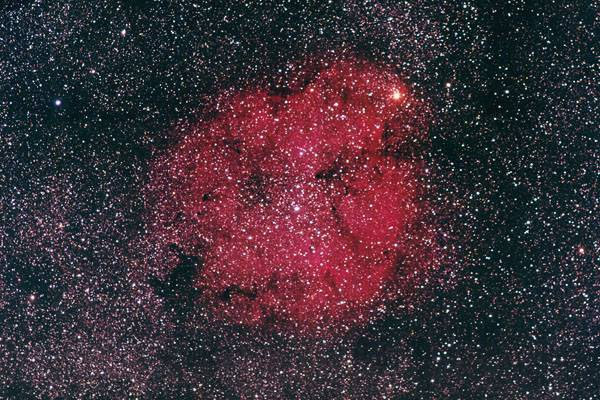

I was fortunate to escape the cold “Michigan Nebula” that seems permanently parked overhead in February. After driving to some business meetings in Atlanta, I rented a 24’ motor home. The gracious members of the Charlie Elliott Chapter of the Atlanta Astronomical society hosted me that night for an impromptu star party. Charlie Elliott is the name of a nature center located an hour southeast of downtown Atlanta. Clevis, Theo, and Jon observed with me until midnight. We became fast friends and enjoyed great astronomical conversation. The 45 degree temperatures felt balmy [to me] and were perfect for trying out my latest toy. In October, I had purchased an AstroTrac TT320 ultra portable camera tracker.
My goal is to use it for wide field images of the sky, using my modified Canon 20D and various lenses. Before this trip, the Michigan Nebula [plus work and family obligations] had prevented me from getting more than one night’s worth of experience. The following image of IC 1396, a very large emission nebula in Cepheus, was taken in early November at Clay Kessler’s house in Manchester. This used my Canon 200mm lens @ f/3.2 and ISO 800 (all the images in this story, save one, use this lens and setting).

My first attempted image on the trip was the Witch Head nebula. A ghoulish silhouette, this blue cloud reflects the light of nearby Rigel of Orion. Rick Krejci has a fantastic image of this on his website. My attempt is not worth showing here. An hour’s worth of 2 minute images just barely shows the witch and she ain’t pretty. During the taking of the images, we heard the howls of nearby coyotes. My hosts told stories of having potentially dangerous wild hogs come upon them while observing.
For my second image I luckily chose a much easier target. The Rosette Nebula is a red nebula, glowing from ionized hydrogen. It’s one of those birthplaces for new stars. It is visible in binoculars under dark skies, just to the left of Betelgeuse of Orion. You can see that the modification of the Canon 20D really helps pick up the red. This trip features a lot of red, as you will see. This Rosette image is from 60 minutes’ worth of exposures using the 200mm lens.
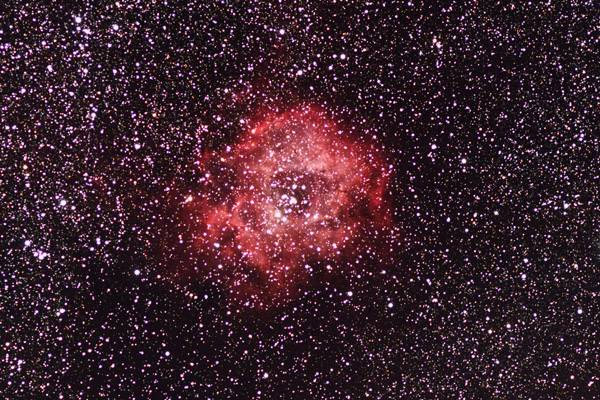
At midnight, it was just Jon and me. A few more winter Milky Way objects, and it was time to pack up. I groggily drove into the park, looking for the primitive campground. It was about 1am when I found it, but I nearly got the motor home stuck while trying to back up (something verboten without a spotter). The ordeal keeps me awake for awhile, along with listening to the surrounding animals in the night (I’m a couple miles from the nearest person). However, the dawn breaks brightly with a great view over the lake:
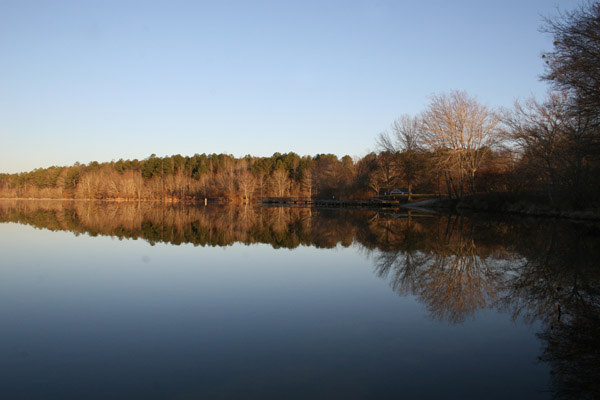
I arrived the next day at Chiefland Astronomy Village. CAV is located in northern Florida, between Gainesville FL and the Gulf of Mexico. CAV is a village where about 25 amateur astronomers have purchased lots & homes. Most are part-time residents. CAV is home to some of the nicest and most generous people you’ll ever meet. It’s easy to see why—they get to pursue their hobby under very dark skies and at great winter temperatures! CAV hosts star parties during dark-of-the moon weekends from late fall to spring. The first weekend I was there, about 25 star partiers were camped there. Tom & Jeannie host the campers, providing the large grassy observing field, electricity, flush toilets, warming room, open-roofed showers and a shaded dining area.

The other Tom (and Lynn) provided me with a place to park and hook up my motor home. Not only that, they provided an observing pad for my Astrotrac and Starmaster 14.5” dob. During the next several days, I helped them host a “rally” for the owners of 12 luxury brand motor homes. We toured CAV observatories, looked at the sun’s prominences, and observed extensively with a 24” dob.
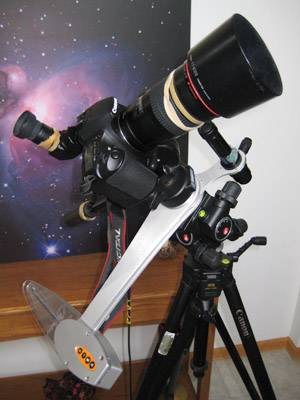
It’s pretty easy to set up and use the AstroTrac. First, I set up the photo tripod and attach the Manfrotto head which has slow-motion dials for three axes (altitude, azimuth and tilt). The AstroTrac then attaches to the tripod head. Finally, a conventional tripod head screws to the AstroTrac to hold the Canon. The AstroTrac is powered by just a trickle of 12V DC power, provided by a battery pack. Polar alignment is quick and easy using a polar alignment scope. (I hope to get a small refractor once I tire of telephoto imaging, and that will probably require some drift aligning in addition to the polar scope.) To start tracking, you just open up the swing arm and push a button. The flashing LED indicates tracking is happening. You get a couple hours of tracking before you have to rewind and start again.
The only other necessary equipment is a hair dryer (for the dew) plus a programmable shutter release.
I chose M31, Andromeda Galaxy, as my first CAV target because it was dropping into the west after sunset. This 200mm image is about 35 two minute exposures.
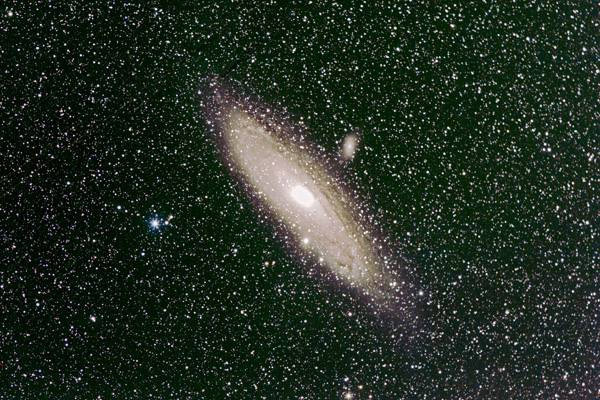
Orion is located way up high in the sky at CAV. A very tempting target with the binoculars, camera and telescope.
Got a pretty good shot of Orion’s belt, including the Horsehead Nebula (just a chunk of dust in the shape of a horse’s head that obscures the red nebula behind). See also the Flame Nebula, which glows due to the nearby Altinak.
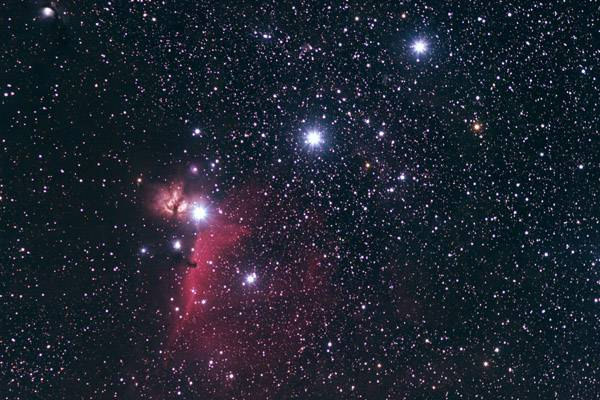
Then I realized that if I rotated the camera I could fit in both the Horsehead and M42.
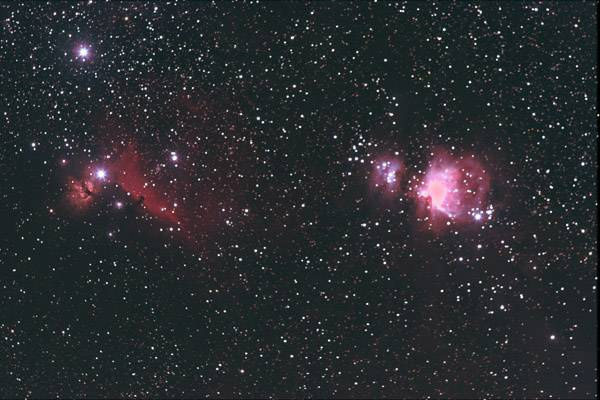
Living in the frozen north for most of my life, I really never got to know the winter Milky Way very well. I certainly had never seen the Seagull Nebula before. It is IC 2177, a combination emission and reflection nebula that is located near (NE) Sirius. It does look like a seagull! At CAV I could see it in my 15x45 binoculars.
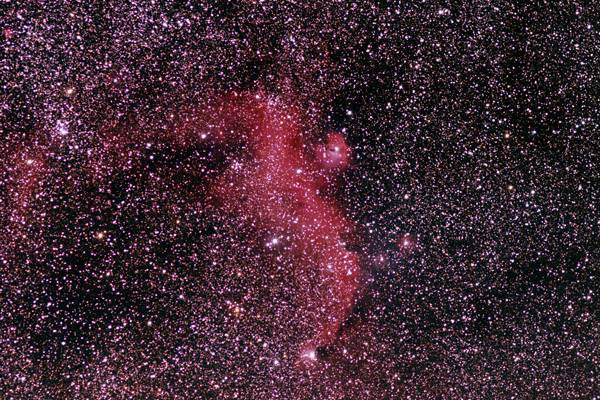
I put the 50mm lens on so I could catch the entire Orion constellation. This is about 70 minutes’ worth of exposures at f/2.8. Barnard’s Loop (another bunch of red gas up there) is easily seen.
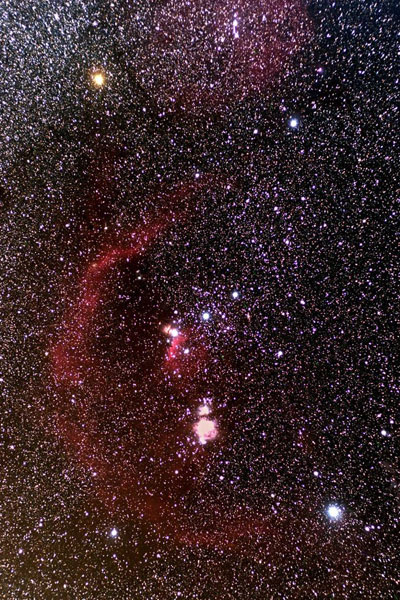
Just like the seagull, I had never seen the California Nebula. It is big, so I could only see it with the 15x45’s. It’s located in Perseus, not far from the Pleiades. The 200mm lens did a good job capturing it with 80 minutes’ of exposures. When I was processing this image, I thought the dark spot was some chunk of dust on my camera’s sensor. But a web search showed that it’s a glob of dust actually obscuring the nebula (CAV has WiFi throughout!).
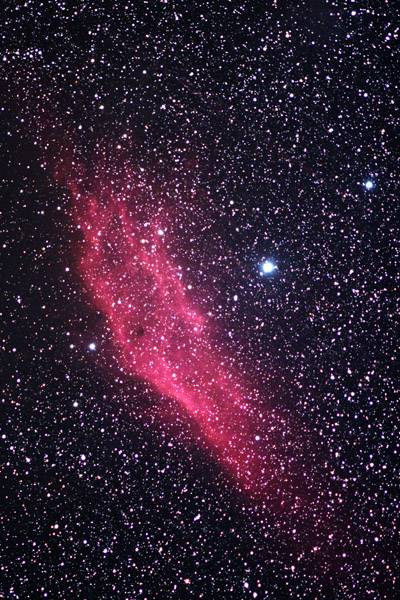
For a couple nights, I set up the camera to automatically take pictures then walked over to the group observing field. I had the 24” dob to myself. Wow. I made a study of Canis Major and Puppis, constellations I’ve not seen much in Michigan. M46 with its freaky imbedded planetary nebula was amazing (I did read somewhere that the planetary wasn’t actually IN the open cluster. It’s closer than the cluster, just in our line of sight). Before long, it was time to walk back to the camera to set up the next shot. In the pitch black Florida night, I walked directly into a fence (disturbing nearby observers, but I was too embarrassed to identify myself). Here’s a shot of Canis Major, with magical lines that appeared in the sky just when the shutter was open.
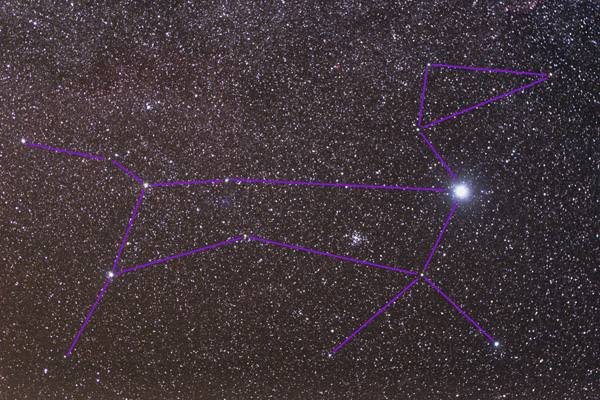
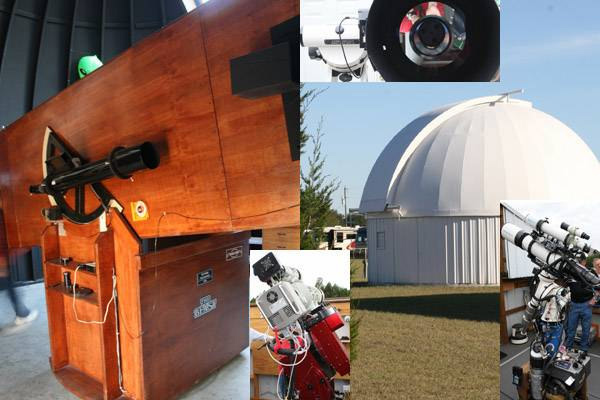
I was able to visit half a dozen of the two dozen observatories at CAV. Most are roll off roofs, but some are home built domes. The largest observatory holds a leviathan 42” dobsonian! We actually looked at the moon with it and I could not see anything with that eye for quite awhile. The most impressive observatory has twin domes, housing entirely home built truss tube, fork mounted 36” & 24” reflectors. Some of the imagers there have shockingly complex rigs with lots of cables, wires and pumps. I watched one astronomer take images of distant galaxies and search for supernovae.
I was impressed with the true “village” nature of CAV. Neighbors are always visiting each other to help build something, borrow something or just say “hi.”
The area northwest of CAV is where the famous Suwannee River drains into the Gulf of Mexico. Lots of swamps, marshland and gators. No lights. So the Milky Way sets in a very dark sky. This allows for good imaging of two great clusters, even as they get low. You could see the Merope nebula in the Pleiades with binoculars.
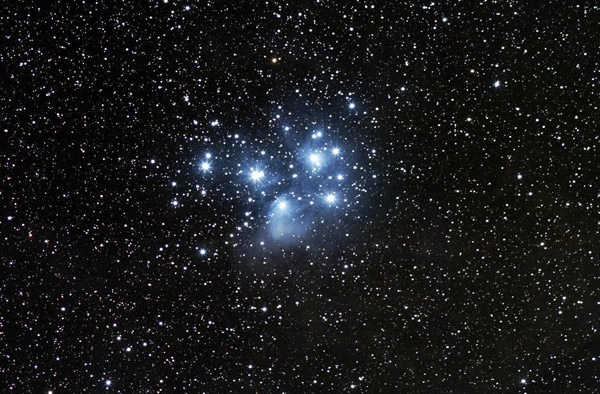
My telescope showed the beautiful tiny (and distant) cluster near M35 called NGC 2168. M35 is at the upper right corner of the picture below. You can see NGC 2168 as an unresolved glow just to the lower right of M35. It is obviously an older cluster, because it is yellow compared to M35’s bluish white. IC 443 is the curved red strip.
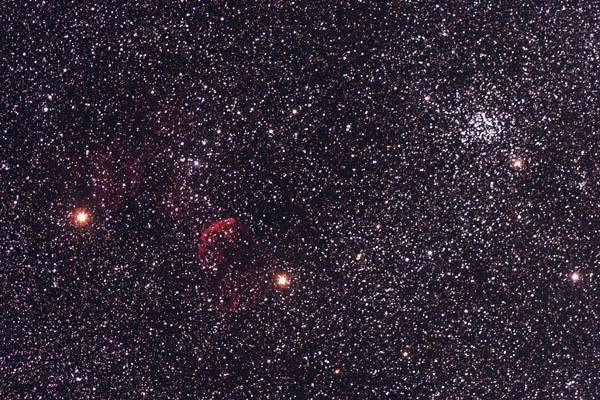
I set my alarm for 4am (after the moon set) to get a picture of the multicolored nebula near Antares. I had trouble focusing my eyes, so it should not be surprising that I could not focus the telephoto. So nothing worth showing here.
Over the course of eight CAV nights I was able to see hundreds of objects with a variety of instruments. Here are the things that stick with me:
After a business meeting in Tampa, I picked up my wife and daughter at the airport. We camped for four nights near Anna Maria Island’s beaches. Our campground featured baby great horned owls that, despite their mom’s prodding, were reluctant to take their first flight.
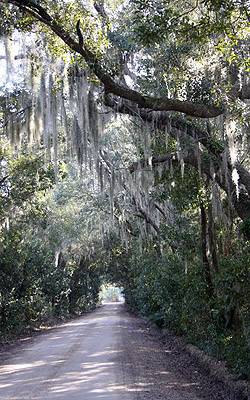
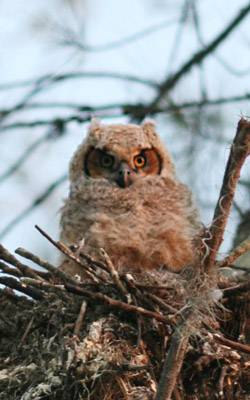
After dropping my family at the Tampa airport, I drove the RV back to Atlanta for [more] meetings. My adventure was capped off by viewing the lunar eclipse beside my hotel in Kentucky.
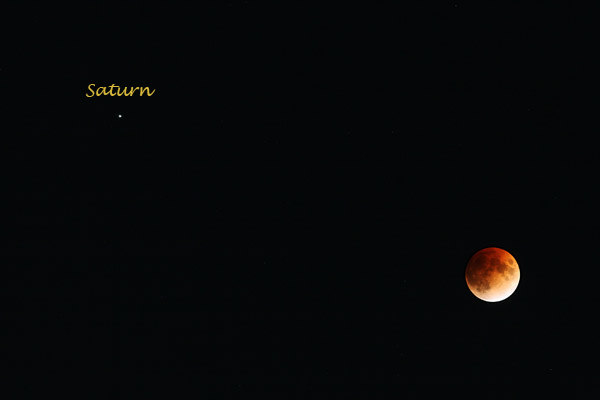
You can get more information at http://chiefland.org/. It is a mere 1050 miles south of Ann Arbor (16.5 hrs down I-75). The average high temperature in February is 67F, and average low is 42F (during my visit, there were two light frosts). The cost is $35/year to join, and $5/night to camp. See also the Yahoo group “Chiefland.” CAV is expanding the observing/camping field for the busy November and April star parties. I hope to return to CAV when the cold “Michigan Nebula” returns.
All photos on this page were taken by Brian Ottum.